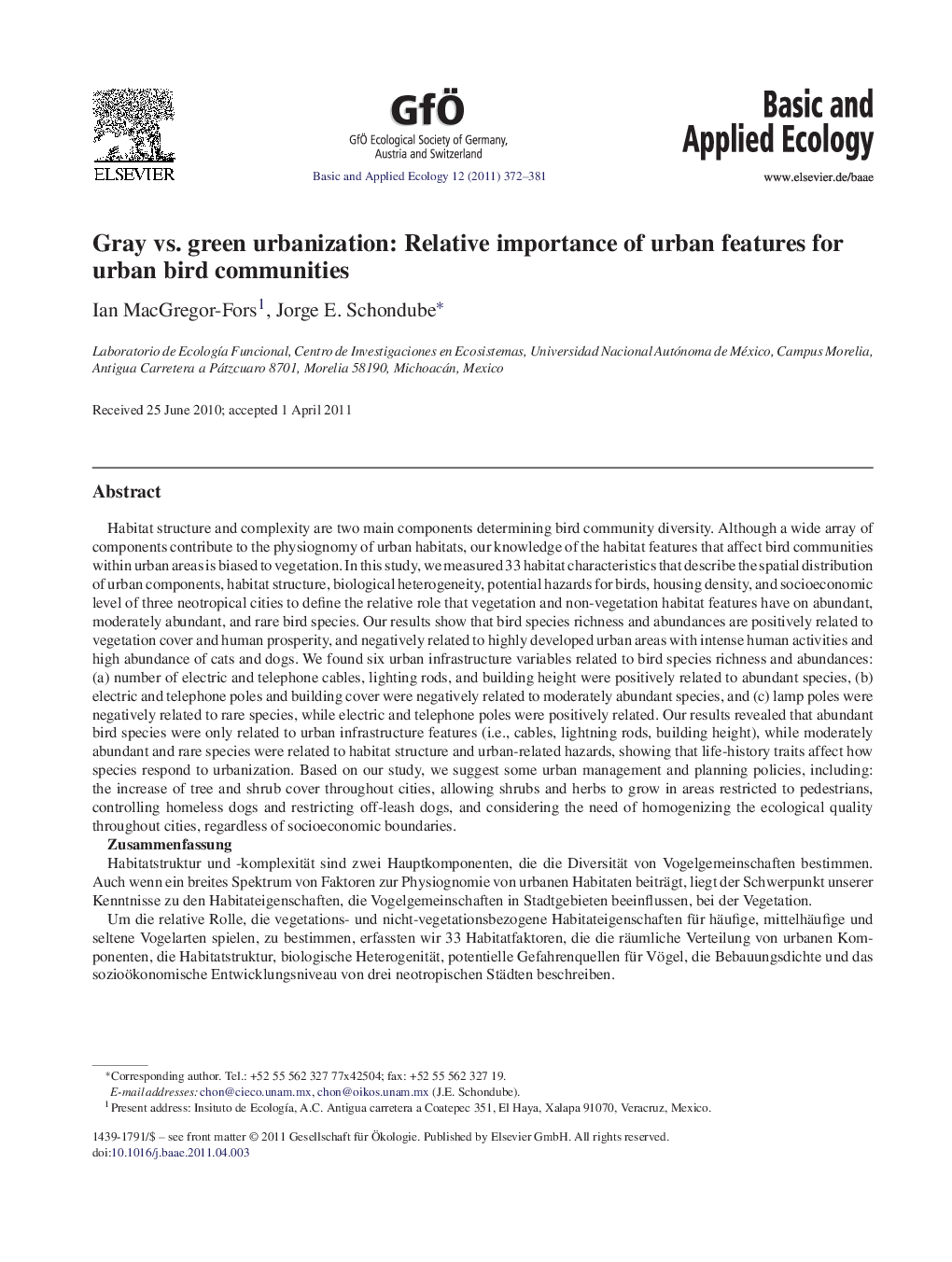| کد مقاله | کد نشریه | سال انتشار | مقاله انگلیسی | نسخه تمام متن |
|---|---|---|---|---|
| 4384314 | 1304406 | 2011 | 10 صفحه PDF | دانلود رایگان |

Habitat structure and complexity are two main components determining bird community diversity. Although a wide array of components contribute to the physiognomy of urban habitats, our knowledge of the habitat features that affect bird communities within urban areas is biased to vegetation. In this study, we measured 33 habitat characteristics that describe the spatial distribution of urban components, habitat structure, biological heterogeneity, potential hazards for birds, housing density, and socioeconomic level of three neotropical cities to define the relative role that vegetation and non-vegetation habitat features have on abundant, moderately abundant, and rare bird species. Our results show that bird species richness and abundances are positively related to vegetation cover and human prosperity, and negatively related to highly developed urban areas with intense human activities and high abundance of cats and dogs. We found six urban infrastructure variables related to bird species richness and abundances: (a) number of electric and telephone cables, lighting rods, and building height were positively related to abundant species, (b) electric and telephone poles and building cover were negatively related to moderately abundant species, and (c) lamp poles were negatively related to rare species, while electric and telephone poles were positively related. Our results revealed that abundant bird species were only related to urban infrastructure features (i.e., cables, lightning rods, building height), while moderately abundant and rare species were related to habitat structure and urban-related hazards, showing that life-history traits affect how species respond to urbanization. Based on our study, we suggest some urban management and planning policies, including: the increase of tree and shrub cover throughout cities, allowing shrubs and herbs to grow in areas restricted to pedestrians, controlling homeless dogs and restricting off-leash dogs, and considering the need of homogenizing the ecological quality throughout cities, regardless of socioeconomic boundaries.ZusammenfassungHabitatstruktur und -komplexität sind zwei Hauptkomponenten, die die Diversität von Vogelgemeinschaften bestimmen. Auch wenn ein breites Spektrum von Faktoren zur Physiognomie von urbanen Habitaten beiträgt, liegt der Schwerpunkt unserer Kenntnisse zu den Habitateigenschaften, die Vogelgemeinschaften in Stadtgebieten beeinflussen, bei der Vegetation.Um die relative Rolle, die vegetations- und nicht-vegetationsbezogene Habitateigenschaften für häufige, mittelhäufige und seltene Vogelarten spielen, zu bestimmen, erfassten wir 33 Habitatfaktoren, die die räumliche Verteilung von urbanen Komponenten, die Habitatstruktur, biologische Heterogenität, potentielle Gefahrenquellen für Vögel, die Bebauungsdichte und das sozioökonomische Entwicklungsniveau von drei neotropischen Städten beschreiben.Unsere Resultate zeigten, dass Artenreichtum und Siedlungsdichte der Vögel positiv mit der Vegetationsbedeckung und dem Wohlstandniveau verbunden waren und negativ mit intensiven menschlichen Aktivitäten und der Häufigkeit von Katzen und Hunden. Sechs urbane Infrastrukturelemente zeigten eine Beziehung zu Artenreichtum und Siedlungsdichte der Vögel: (a) Die Anzahl von Elektro- und Telefonkabeln, Laternenpfähle und die Gebäudehöhe zeigten eine positive Beziehung zu den häufigen Arten. (b) Elektro- und Telefonmasten und die Bebauungsdichte zeigten eine negative Beziehung zu den mittelhäufigen Arten. (c) Die seltenen Arten zeigten eine negative Beziehung zu Lampenmasten, aber eine positive zu Elektro- und Telefonmasten. Unsere Ergebnisse deckten nur Beziehungen zwischen häufigen Vogelarten und Infrastrukturelementen (Kabel, Masten, Gebäudehöhe) auf, während mittelhäufige und seltene Arten Beziehungen zu Habitatstruktur und urbanen Gefahren aufwiesen. Dies zeigt, dass biologische und ökologische Eigenschaften beeinflussen, wie Arten auf die Urbanisierung reagieren. Basierend auf unserer Studie schlagen wir einige Richtlinien zu Stadtmanagement und -planung vor: gesteigerte Bedeckung durch Bäume und Sträucher, Sträucher und Stauden in Fußgängerbereichen, Kontrolle herrenloser Hunde und Beschränkungen für freilaufende Hunde sowie Berücksichtigung der Notwendigkeit einer übergreifenden Angleichung der ökologischen Qualität unabhängig von sozioökonomischen Grenzen.
Journal: Basic and Applied Ecology - Volume 12, Issue 4, June 2011, Pages 372–381